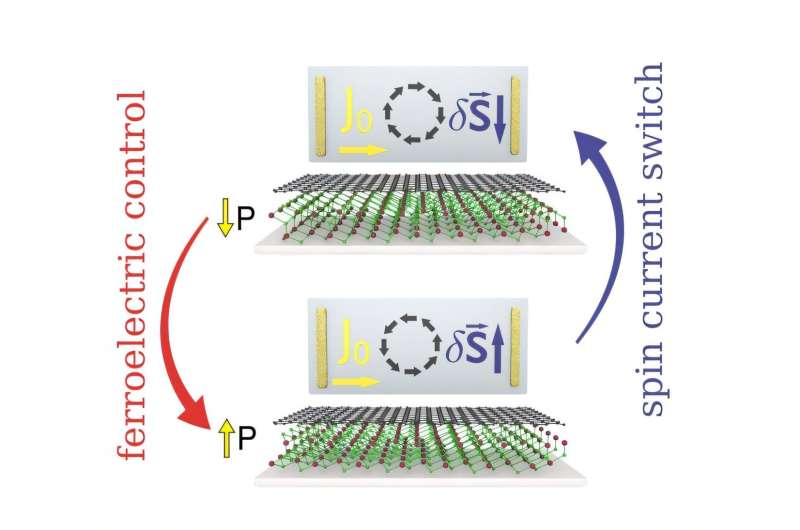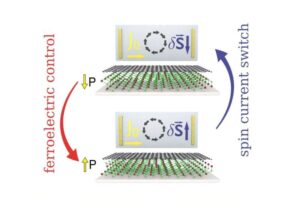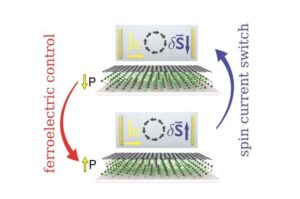
A collaborative team of researchers from the **Slovak Academy of Sciences** has achieved a breakthrough in the control of spin currents in graphene by integrating it with a ferroelectric material, specifically **In2Se3**. This innovative approach, detailed in the journal **Materials Futures** on **November 14, 2025**, utilizes ferroelectric switching to reverse the direction of spin currents in graphene, which could pave the way for the development of energy-efficient spintronic devices.
The researchers employed first-principles and tight-binding simulations to demonstrate that manipulating the ferroelectric properties of **In2Se3** can serve as an electrical spin switch. This finding marks a significant advancement toward creating non-volatile and magnet-free spintronic devices, enhancing the potential for next-generation logic and memory systems that rely on spin rather than charge.
Understanding Spintronics and the Role of Graphene
Over the past two decades, spintronics has emerged as a vital area of nanoelectronics, leveraging the intrinsic spin of electrons to process and store information. Unlike traditional electronics that depend on charge, spintronic devices promise substantial reductions in power consumption and heat generation while offering faster operation speeds and non-volatile data retention.
Despite significant advancements in materials and device architecture, a key challenge remains: achieving precise and low-energy electrical control over spin currents without external magnetic fields. While magnetic manipulation is effective, it complicates scalability and energy efficiency in devices. In this context, two-dimensional materials like graphene have become the focus, given their exceptional electronic mobility and long spin-relaxation times.
Innovative Heterostructures and Ferroelectric Control
Graphene’s potential in spintronics is somewhat limited by its weak intrinsic spin-orbit coupling, which hinders direct spin control. To address this, researchers have explored van der Waals heterostructures, where graphene is combined with other 2D materials to create new functionalities through proximity effects. A promising approach involves coupling graphene with ferroelectric materials, which have spontaneous electric polarization that can be modulated by an external voltage.
In this study, the researchers introduced a novel graphene/In2Se3 heterostructure. They found that the electric dipole from the ferroelectric material can break inversion symmetry at the interface with graphene. This interaction enables the modulation of spin-orbit coupling, allowing for electric switching of spin currents.
The team investigated two configurations of the graphene/In2Se3 heterostructure: a perfectly aligned interface at **0 degrees** and a twisted geometry at **17.5 degrees**. Their calculations revealed that flipping the polarization direction of **In2Se3** reverses the charge-to-spin conversion coefficient, effectively acting as an electrical “chirality switch” for spin currents in graphene.
At **0 degrees**, the system demonstrated a conventional **Rashba-Edelstein effect (REE)**, where an applied charge current generates a transverse spin accumulation aligned with the ferroelectric polarization. Conversely, at **17.5 degrees**, the system transitioned into a regime characterized by an **unconventional Rashba-Edelstein effect (UREE)**. Here, the spin current aligned closely with the charge flow, driven by a newly identified radial Rashba field, a phenomenon previously unexplored in planar graphene systems.
These findings provide a theoretical framework for developing graphene-based spin transistors controlled by ferroelectric switching, potentially leading to the next generation of spin logic and memory devices that prioritize low energy consumption and high speed.
The research team emphasizes the promise of integrating ferroelectric materials with graphene to unlock new spintronic functionalities. Future research will focus on experimental validation of these theoretical results to realize fully electrically controlled, non-volatile spintronic devices, enhancing the landscape of next-generation technology.






